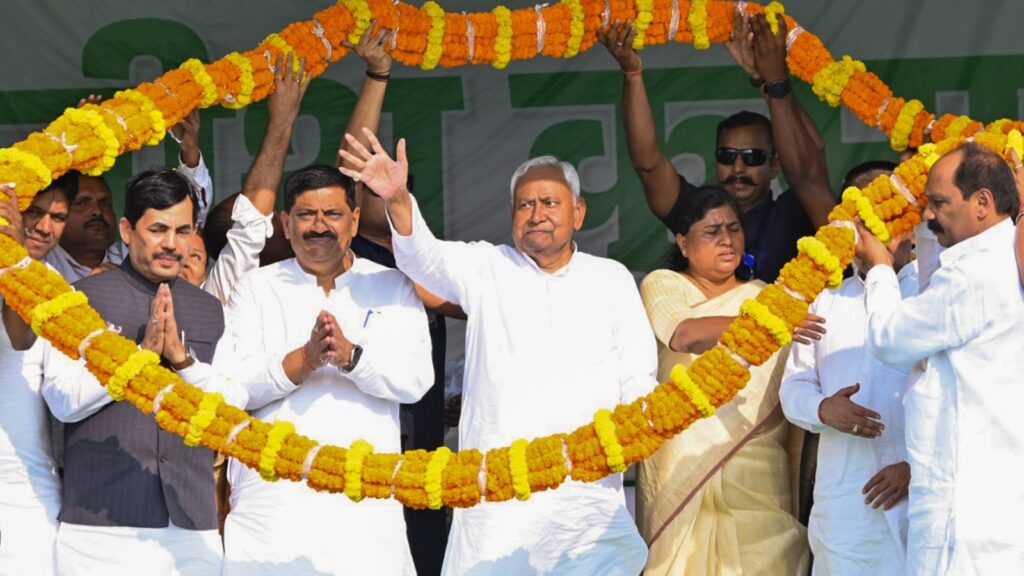Over the last two decades that Chief Minister Nitish Kumar has been at the helm of Bihar, the state has been widely known as India’s most impoverished, lagging behind on almost all socio-economic indicators.
Despite Bihar’s laggard status, the JD(U) supremo has developed a reputation for good governance, earning Nitish the moniker of ‘sushasan babu’. On the eve of elections that are being considered his last, an analysis of socio-economic indicators, from the start of his first term as CM in 2005 to now, shows how far Bihar has come under Nitish.
On a range of indicators in the National Family Health Survey (NFHS), from 2005-06 to 2019-21 (the latest available data), Bihar improved at a faster rate than the national average under Nitish, drawing the state much closer to pan-Indian living standards than when he took over.
However, there’s still work to be done as Bihar remains the poorest Indian state. According to the NITI Aayog’s Multidimensional Poverty Index (MPI), which is a composite measure of deprivation based on a number of socio-economic indicators, one in every third person in Bihar (or 33.76 per cent) is still multidimensionally poor, compared to the national average of 15 per cent.
Electricity
According to the NFHS data, by 2019-21, Bihar had almost caught up with the national average in household electrification – 96 per cent of households in the state reported electricity as their main source of lighting, compared to 97 per cent across India.
In 2005-06, only one in four households in the state had electricity, while the national figure was around two-thirds.
Which means that in about 15 years, Bihar’s electrification rate grew by nearly 250 per cent, against a 42 per cent increase at the all-India level – a reflection of both Bihar’s low starting base and the rapid expansion of rural electrification in this period. The widespread installation of infrastructure for provision of electricity is considered one of the major achievements of Nitish’s tenure.
However, the rider is that these numbers only consider households reporting electricity as their main source of lighting, not the quality or duration of supply of electricity. It does not verify whether the household is connected to the grid, receives reliable power, or uses electricity for appliances beyond lighting.

Sanitation
According to the NFHS, a household is said to have an improved sanitation facility if it uses a toilet that safely separates waste from human contact. This includes toilets that are connected to a sewer system, a septic tank, or a covered pit. Ventilated or slab-covered pit toilets, twin-pit systems, composting toilets, and bio-toilets are also counted as improved.
By 2019-21, almost half the households in Bihar declared having access to an improved source of sanitation, while across India, seven out of 10 households declared the same. From 2005-06, when Bihar was at around 15 per cent, access to sanitation has increased more than three times in the state, while India has grown at less than 2.5 times. Access to an improved sanitation facility has grown from 30 per cent to more than 70 per cent in 2019-21.
Drinking water
When Nitish took oath as CM, around 2 per cent of Bihar had access to drinking water that was piped into their dwelling, yard, or plot. In 2019-21, this number went up to 9 per cent. A large majority (83 per cent) still have to make do with a tubewell or borehole.
Across India, one-third (33 per cent) of the households reported having direct access to piped drinking water into their homes by 2019-21. It had gone up from one out of every four households in 2005-06.
Bihar has thus made faster progress than the national average, but it still lags far behind in terms of actual access.
Women with more than 10 years of schooling
Over the past two decades in power, Nitish has carefully cultivated a constituency that cuts across caste and class lines: women. One of the first and most visible of his women-focused initiatives was the Mukhyamantri Balika Cycle Yojana introduced in 2006, providing free bicycles to school girls.
Women in Bihar with more than 10 years of schooling rose by more than 3.5 times to reach 29 per cent by 2019-21. Pan-India numbers in 2019-21 were better at 41 per cent, but have grown slowly compared to Bihar, at an increase of less than threefold.
Institutional births
The proportion of births taking place in a health facility signifies both effectiveness of public health schemes as well as expenditure on medical infrastructure.
In 2005-06, only 22 per cent of births in Bihar were institutional. By 2019-21, this has increased to 76 per cent, a more than threefold increase.
However, India has grown at a much slower pace, from 39 per cent institutional births in 2005-06 to 89 per cent in 2019-21.
A note of caution: While Bihar’s growth on some indicators is impressive, a high percentage growth should also be seen in the context of the state starting from a very low base and having much more room to grow than other states.

